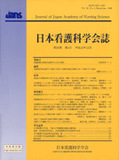Japanese
English
- 販売していません
- Abstract 文献概要
- 参考文献 Reference
要旨
本研究は術後せん妄を観察するための術後せん妄症状を構造化することを目的とした.方法は,国内で報告された術後せん妄症状を網羅的に収集し,看護師の観察によって把握できる81項目を抽出した.この81項目から質問紙を構成し,861名の看護師を対象に「臨床場面で出会った頻度」を5段階の順序尺度で調査した.298名が分析対象となり,因子分析の結果,9因子51項目が抽出された.9因子は「拘束からの逃避」「認知の混乱と攻撃性」「訴えの亢進と減退」「幻覚」「乏しい表情」「関心の欠如」「活動の亢進」「不眠」「反応の低下」であった.すべての因子が,米国精神医学会の精神疾患診断統計マニュアル(DSM-Ⅳ)に記載されたせん妄の特徴に含まれる構造であった.因子毎のCronbach's α係数は,「関心の欠如」では0.58であったが,他の8因子では0.7以上を示し,一定の信頼性を確認できた.
Abstract
The purpose of this study was to observe the structure of postoperative symptoms of delirium. The method was as follows: (1) inclusive collection of symptoms which had been reported in connection with postoperative delirium in Japan;and (2) extracting samples of 81items which nurses can observe. Finally, a questionnaire was drawn up consisting of the 81items using a 5- point ordinal scale. The frequency with which 861 nurses had encountered the 81 items was surveyed, and the responses of 298nurses were used for the data analysis.
From the results of factor analysis, the symptoms of postoperative delirium included nine factors composed of 51 items: “escape from restrictions,”“confused cognition and aggressive tendency,”“acceleration and decline of complaints,”“hallucinations,”“flat affect,”“apathy,” “exasperated action,” “sleeplessness,” and “decrease in the reaction.” Nine factors were contained in five features for delirium according to Diagnostic and Statistical Mannual of Mental Disorders (4th ed). Although Cronbach's alpha for “apathy to one's surroundings”was 0.58, each of the other eight factors indicated a certain level of internal consistency, over 0.7.
Copyright © 2006, Japan Academy of Nursing Science. All rights reserved.


